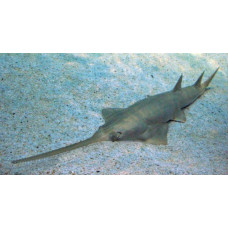Latin name
Pristis zijsron
Other name
Narrowsnout sawfish or green sawfish.
Identification
The longcomb sawfish has an elongated, flat rostrum with tooth-like projections on either side. It is covered with electroreceptors that detect the slightest movement of potential prey buried on the bottom. The teeth are firmly and deeply anchored in hard cartilage and do not regrow if damaged. The green pylorus has the longest rostrum of any of its congeners, reaching 166 cm in length. It is covered with 23 to 37 (average 25-34) pairs of teeth on each side. The longcomb sawfish has a slightly flattened, long body. The mouth, nostrils and gill slits are on the ventral surface like other rays. The mouth has small teeth. Behind the small eyes are spiracles that pump water through the gills and allow the ray to lie motionless on the bottom. The skin is covered with placoid scales.
Features of fish fins
The anal fin is absent. There are 2 fairly large dorsal fins of about equal size, broad pectoral fins and lower pelvic fins of triangular shape, caudal fin with a developed upper lobe.
Fish colouring
The dorsal surface of the body is olive to greenish brown, the sides are yellowish and the belly is creamy white. The rostral denticles are usually pale cream or yellow, contrasting with the dark surface of the rostrum. Eyes are grey or silver with black pupils. Dorsal fins are dirty greyish yellow.
Distribution
Widespread in the tropical waters of the Indian and western Pacific Oceans: along the coast of South Africa, in the Red Sea, in the Persian Gulf, off the coasts of South Asia, the Indo-Australian Archipelago and East Asia as far as Taiwan and southern China. Of all the pilorhyls, this species is the most tolerant of cold water. In Australian waters, for example, Longcomb sawfish are found as far north as Sydney, while the range of other pylorus extends much further north. In the Red Sea and the Persian Gulf, these pylorans were once quite abundant, as well as off the north-west coast of Australia. They are now found off the coasts of Bahrain, Eritrea, Indonesia, Papua New Guinea, Kenya, Malaysia, Qatar, Sudan, Timor Leste and the United Arab Emirates. They are thought to have disappeared from their former habitats in the waters of Mauritius, South Africa and Thailand.
Habitat
A tropical marine and freshwater species. These fish are kept in coastal waters and river mouths in shallow water, although they are sometimes found at depths in excess of 70 metres. In the Gulf of Carpentaria, a 27-year-old female was caught living in freshwater at less than 1 metre depth within two hundred metres of a mangrove-covered coastline. Another individual was found in freshwater 240 km off the coast of the Northern Territory.
Size
With a maximum recorded length of 7.3m, it is probably the slowest growing member of its family.
Behavior
Occurs on both island and continental shelves, but is now thought to be extinct in much of its original range. Coastal and intertidal species are known to enter freshwater in some areas. It is found in shallow bays, estuaries and lagoons. Often found on the bottom with the sawfish raised at an angle to the body axis.
Food and feeding habits
They are bottom dwelling fish that feed on crustaceans, molluscs and small fish. In search of food, they use their snouts to dig up the bottom, injure their prey and defend themselves against their few natural enemies, sharks and crocodiles. Their "saw" is dotted with electroreceptors that help them locate prey in murky water.
Reproduction
They reproduce by oviparity. Fertilisation is internal, the embryos develop in the womb and feed on the yolk. These rays grow and mature slowly. The newborns are 60-108 cm long and probably emerge tail first. Their rostral denticles are sheathed and reach their final size relative to the rostrum only after birth. Birth occurs during the rainy season. Males reach sexual maturity at a length of about 4.3 m.
Fishing
Have been fished commercially for a long time. Their serrated rostrum makes them very vulnerable - they can become entangled in nets and floating debris.
Relationship with a person
Traumatogenic. Longcomb sawfish are not dangerous to humans. However, due to the large size and sharp teeth of the rostrum, these fish should be handled with care. The meat of these fish, especially the fins which are an ingredient in the famous soup, is highly prized. The liver fat is used in folk medicine. The price of a rostrum can reach $1,000 or more.
| Classification | |
| Phylum | Chordata |
| Class | Chondrichthyes |
| Squad | Rhinopristiformes |
| Family | Pristidae |
| Genus | Pristis |
| Species | P. zijsron |
| Features | |
| Conservation status | Critically Endangered |
| Habitat | Bottom |
| Life span, years | No information |
| Maximum body weight, kg | No information |
| Maximum length, cm | 730 |
| Sailing speed, m/s | No information |
| Threat to people | Edible |
| Way of eating | Predator |
Longcomb sawfish
Tags: longcomb sawfish

